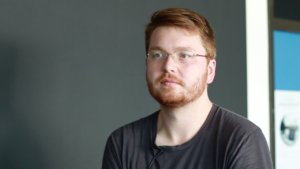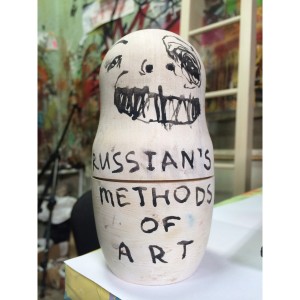Julius: I spent the last few weeks in the forest where I chose a tree which I cut down by walking around it with a pocket knife for an entire day. And today I will go back to the tree in the forest. It is such a sunny day, a beautiful autumn day. I planted an artificial tree in the forest. A tree recreated entirely of synthetic materials and it is now in the Grunewald and I will take pictures of it later, because in autumn there is of course a very different visual effect than in the winter or in the spring or the summer where I have photographed it already. My artwork is a collection of objects and images that have been created in the course of my life and which somehow freeze the thoughts that I had in the form of an object or an image or sometimes it is only a documentation of actions that I made, but which you cannot really freeze. All those situations are actually gone, but by freezing aspects of them using photographs or videos, I hope that some time all these objects tell a story that somehow is interesting for somebody. This is how I would describe my artwork.
I am experimenting a lot with pendulums. For one or two years already. And this is going to be the artwork that I will implement within the next two weeks. I will install two pendulums, where I hang up the gallery’s equipment and then I make it swing and this is how a relationship between the objects in the gallery is created, because sometimes they swing together and then in the opposite way. Yes, there is some sort of romance between the objects in the gallery.
Julius: Ich habe die letzten Wochen viel im Wald verbracht und habe mir einen Baum ausgesucht, den ich gefällt habe, indem ich mit einem Taschenmesser einen Tag lang im Kreis um ihn herum gelaufen bin. Und heute werde ich wieder zu dem Baum in den Wald gehen. Es ist gerade eine schöne Sonne, ein schöner Herbsttag. Ich habe einen künstlichen Baum in den Wald gepflanzt. Einen Baum nur aus synthetischen Materialien nachgebaut und der steht jetzt im Grunewald und den werde ich nachher fotografieren, weil das im Herbstkontext jetzt natürlich eine ganz andere visuelle Wirkung hat als im Winter oder im Frühling oder im Sommer wie ich ihn bisher fotografiert habe. Mein Werk ist eine Ansammlung von Objekten und Bildern, die im Laufe meines Lebens entstanden sind und die irgendeinen Gedanken, den ich da hatte einfrieren in Form eines Objekts oder in Form eines Bildes. Oder manchmal sind es auch nur Dokumentationen von Aktionen, die ich gemacht habe, die man nicht wirklich einfrieren kann. Die eigentlich vorbei sind, wo ich aber dann über ein Video oder ein Foto einen Aspekt irgendwie eingefroren habe und ich hoffe, dass dann eben mit der Zeit diese ganzen Objekte eine Geschichte erzählen, die irgendwie irgendjemanden interessiert. Das würde ich so als mein Werk bezeichnen. Ich experimentiere gerade viel mit Pendeln. Schon seit ein, zwei Jahren. Und das wird auch die Arbeit, die ich innerhalb der nächsten zwei Wochen umsetzten werde. Das sind zwei Pendel, wo ich in der Galerie die Einrichtung der Galerie aufhänge, an zwei Pendel und ins Schwanken bringe und dann so eine Beziehung zwischen den Objekten in der Galerie schaffe, indem sie zusammen schwingen und manchmal auseinander schwingen. Ja, so eine Art Romanze zwischen den Objekten in der Galerie.
Julian: The last two years I was very much concerned with the time and how time is transformed into material. Or how you can store time or what kinds of materials are able to capture time? How does time become material. I started to work a lot with mold, because processes of decay reveal a completely different temporariness and my starting point of the whole idea was in China, in Beijing, I guess. No, it was not in Beijing but in Shanghai where time passes much faster than in Berlin. I was there and then we went into a Chinese garden and time is somehow dead in there. So there is no more sense of time. Since 2000 years nothing has ever changed in there and you have this very strong sense of time, how different the perception of time can be.
Julian: Ich habe mich die letzten zwei Jahre sehr viel mit Zeit beschäftigt und wie Zeit zu Material wird. Oder wie kann man die Zeit speichern oder was für Materialien fangen sozusagen die Zeit ein? Da habe ich angefangen viel mit Schimmel zu arbeiten, weil diese Verfallsprozesse Temporalität zeigen. Mein Ausgangspunkt von dem Ganzen war, glaube ich, in China in Beijing. Ne nicht in Beijing, sondern in Shanghai wo ja Zeit viel schneller ist als in Berlin. Ich war da und dann sind wir in einen chinesischen Garten gegangen und da ist die Zeit irgendwie tot. Also es gibt kein Zeitgefühl mehr. Seit 2000 Jahren hat sich da nichts verändert und man hat dieses sehr starke Zeitgefühl. Also wie Zeit unterschiedlich wahrnehmbar ist.
Julius: All the artworks that you do become pieces of a big puzzle in the oeuvre of everything. And it is somehow funny that both of us have the same piece of a puzzle, belonging on the one side to my work and on the other side to his work. And it also has a different meaning in the different contexts of art. For me, it has naturally a different meaning than to him but we also have a common meaning when we only exhibit this one artwork. And this is very, very nice. You can learn a lot about the effects of these artworks. When I see the pigeons in his portfolio or in his exhibition, I see them in quite a different way than in my work context.
Julius: Alle Arbeiten, die man macht, werden ja zu einem Puzzlestein in dem Gesamtwerk von allem. Und das ist halt witzig, dass wir beide diesen selben Puzzlestein haben. Der einerseits zu meinem Werk gehört und andererseits zu seinem Werk. Und dann in den verschiedenen Kontexten der Werke auch eine andere Bedeutung hat. Für mich hat es natürlich auch eine andere Bedeutung als für ihn aber wir haben auch eine gemeinschaftliche Bedeutung, die wir haben, wenn wir nur diese eine Arbeit ausstellen. Und das ist ganz, ganz schön. Man lernt auch selber viel darüber wie solche Arbeiten wirken. Wenn ich jetzt in seinem Portfolio oder in einer Ausstellung von ihm die Tauben ausgestellt sehe, dann sehe ich die ja ganz anders als wenn ich die bei mir sehe.
Julian: I started to bring along sand from all over the world to this place. And with this sand, I created sandpaper that is made of the sand of 195 recognized countries of the UN. So the sand comes from the 195 recognized countries. And with this sandpaper I ground diligently globes. And I have done a first work with thirteen globes where I just grind off 150 years of history with their own illustrations. When the representation and the represented are mixed together and they found something new. So the dust falls onto the floor and creates a new landscape. And now I simply extend the concept. I have always sanded globes and now I will break them and then again a landscape will arise, which is also a bit like a quote from the 60s and Robert Smithson „Islands of Broken Glass“. So it quotes many, very well-known works that had to do with glass and scenery, but in a new interpretative way, so to speak.
Julian: Ich habe angefangen Sand aus der ganzen Welt hier her zu bringen. Und mit diesem Sand habe ich ein Sandpapier hergestellt, das aus dem Sand aus 195 anerkannten Ländern der UN hergestellt ist. Also der Sand kommt aus den 195 anerkannten Ländern. Und damit schleife ich ganz fleißig Globen, also Weltglobusse. Und ich habe eine erste Arbeit gemacht mit dreizehn Globussen. Also 150 Jahre Geschichte einfach abgeschliffen mit seinen eigenen Darstellungen. Wenn die Darstellung und das Dargestellte sich durcheinander mischen, dann entsteht etwas Neues. Vor allem wenn der Staub auf den Boden fällt. Dann entsteht eine neue Landschaft. Und jetzt erweitere ich einfach das Konzept. Also ich schleife nicht mehr nur noch Globusse, sondern jetzt werde ich sie einfach zerbrechen und dann entsteht auch wieder eine Landschaft, die auch ein bisschen anspielt auf ein Zitat aus den 60ern und Robert Smithons „Islands of Broken Glass“. Also ganz viele, ganz bekannte Arbeiten, die mit Glas und Landschaft zu tun hatten aber jetzt eben ein bisschen neu interpretiert sozusagen.

















